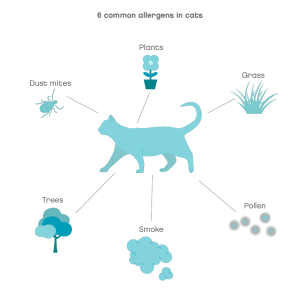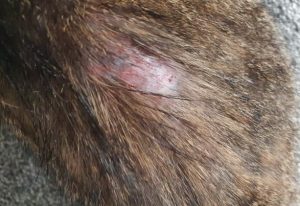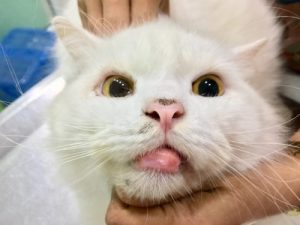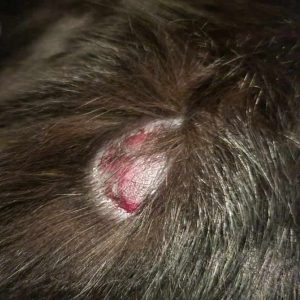Skin allergies in cats are a common condition. In this article, we discuss atopic dermatitis, caused by allergies to the environment. These allergies affect up to 12% of cats in the UK. Skin allergies can occur at any age, but symptoms often start around 1-3 years old.
Skin allergies are due to a reaction to allergens in the environment. They are also known as feline atopic skin syndrome, atopy, environmental allergies, atopic dermatitis, or allergic skin disease. Cats diagnosed with this condition will need life-long treatment but can have a good quality of life with the correct treatment plan.
Overview
What are skin allergies in cats?
Environmental allergies in cats are complex and can be defined in different categories:
- Feline Atopic Syndrome includes environmental allergies, food allergies, and asthma.
- Feline Atopic Skin Syndrome describes when there are environmental allergies.
- Food and flea allergy symptoms are often similar to environmental allergy signs, and cats can suffer from a combination of these. 13% of cats with allergies have both food and environmental allergies.
Atopic dermatitis is a skin disease due to a reaction to allergens in the environment.
- In cats with atopic dermatitis, when allergens come in contact with the skin, the immune system has an exaggerated response
- This inflammatory response is the reason for the main sign of atopy, which is itching
- Itching and scratching often lead to a skin infection, cause by bacteria or yeast
- It has been proven that there is a genetic component to atopic dermatitis in cats
- Atopic dermatitis can get worse during certain seasons of the year (12-18% of cases)
- Common allergens include pollen, dust, grass, cigarette smoke and plants.

The signs of skin allergies can worsen without the correct treatment plan. Our Joii team is available 24 hours a day for advice; call us now if your cat has allergies.
Symptoms
Symptoms of skin allergies in cats
Itching is the main symptom of skin allergies. It may not always be obvious that your cat is itchy. Some cats will secretly scratch or show other signs of being itchy, such as chewing, biting, rubbing, and licking.
Other signs include:
- Red, inflamed skin
- Hair thinning or hair loss
- Over-grooming
- Skin lesions, such as white-head spots, red spots, a rash, crusts, and scabs
- Thickened areas of skin
- Hot spots

- Overgrooming is a common sign

- Red skin and rashes are common with allergies
Symptoms can affect other areas of the body:
- Respiratory signs, such as sneezing and wheezing, occur in 6-7% of cases
- Eye problems, such as conjunctivitis
- Ear problems and infections in 16-20%
- Gastrointestinal signs, such as vomiting and diarrhoea, affect up to 9%
Cats develop specific skin patterns that are related to allergies:
- Miliary dermatitis: small crusted lesions on the skin
- Eosinophilic granuloma complex: consists of eosinophilic plaques, eosinophilic granulomas, or indolent ulcers. Plaques are flat, red patches of skin, usually found on the tummy, that are very itchy. Granulomas are usually found on the paws or in the mouth and are raised and thickened areas of skin that can be ulcerated. Indolent ulcers are found on the lip and can lead to swelling of this area.
- Ulcers and erosions of the head and neck

- Swollen lip due to indolent ulcer

- Plaque on the skin of a cat
Risk
Are some cats more at risk of skin allergies than others?
Any cat, regardless of breed, sex, or age, can develop this condition.
There are some risk factors, such as:
- Genetic component
- Breed predisposition: Abyssinians, Maine Coons, Persians, Himalayans, and Devon Rex.
- Age: The symptoms usually start when they are under 3 years old.
Is my family at risk of catching skin allergies?
Atopic dermatitis in cats is not contagious to humans or other pets in the household.
Diagnosis
How are skin allergies diagnosed in cats?
Environmental allergies in cats can be complex to diagnose. Because the symptoms can be similar to those of many other conditions, we need to rule out other causes in a systematic way.
A full physical examination is important as the first step in determining what parts of the body are affected and how severely they are affected.
Skin testing
- Skin scrapes to check for mites such as Sarcoptes and Demodex (mange)
- Flea paper test to check for flea dirt
- Skin swabs to look at any areas of skin infection and determine what type of bacteria or yeast are present
- Skin biopsy and hair plucks may also be done
Food trial
- Once parasites are ruled out, the next step is to check for food allergies.
- A hydrolysed protein diet is used for at least 6–8 weeks to assess the response. Hydrolysed diets are made from proteins that are broken down into small pieces to avoid any immune reaction.
Allergy tests
- Blood or skin tests that check for specific allergens in your cat’s body.
- Sedation is needed for skin tests.
- An exam with a scope to look down the ear canals
- Swabs of the ears to check what type of infection is present
Blood and urine tests
- To check for any other conditions such as kidney disease, hyperthyroidism or diabetes
Vet treatment
What’s the treatment for skin allergies in cats?
Treatment for skin allergies usually involves a multi-modal approach to reduce or completely eliminate the signs. This involves working with your vet to try different options to find what works best for your cat.
Treatment of secondary skin infections
- Antibiotics or antifungals may be needed
- Depending on how severe the infection is, treatment may be topical (shampoo, wipes, or creams), oral or by injection
- Parasite treatment to protect against fleas and other parasites
Anti-itch medication
- Anti-histamines work well for some cats with mild itching
- Steroid sprays alone may be used for some cases
- Steroid tablets are very effective and inexpensive, but can lead to side effects such as obesity and lethargy.
- Ciclosporin (an immunosuppressant) is an oral medication used for treating allergies in cats.
Allergen-specific immunotherapy
- A medication made specifically for each patient based on the results of skin or blood tests for allergies.
- Helps to desensitise the body to different allergens. It works to reduce the severity of the symptoms of allergies and is usually given by injection every 2-4 weeks.
- It can be expensive in the beginning to set-up but less so with ongoing treatment. Side effects are rare with this treatment.
Ear infections
- Ear cleaners to clean the canal and break up the wax
- Medicated ear drops containing antibiotic, anti-inflammatory, and antifungal components
Home treatment
How to look after a cat with skin allergies at home
Allergies can be tricky to treat, and it’s recommended to take a multi-modal approach. This means using different products and methods to improve the signs. Depending on the severity of the symptoms, some cats with mild itching may only need prescription medication during a seasonal flare-up.
At home recommendations
- Keep your cat up to date with parasite preventatives, especially fleas
- Feed a good quality, complete diet. There are some foods that are specifically made for cats with allergies.
- If your cat is diagnosed with specific allergies, try to avoid contact with them. For example, keep them indoors if the pollen count is high, hoover and dust regularly, avoid fragranced or dusty litters, do not smoke near your cat, and feed certain foods.
- Skin supplements containing omega oils can improve the skin barrier
- Use a buster collar or medical suit to prevent self trauma
- Calming or medicated shampoos, mousses, wipes, and gels are useful for certain conditions, including mild skin infections. These are often antibacterial and also soothe the skin.
- Regular ear cleaning may be advised if your cat is prone to infections. Some ear cleaners can also help with mild irritations or infections.
It’s always best to seek the advice of a vet if your cat shows signs of being itchy. Home remedies may be helpful for certain conditions, and your vet can guide you on the best ones to look for.
Tips on how to live with a cat with skin allergies
Atopic dermatitis is a life-long condition. Costs of treatment may be higher with certain medications or at the beginning of treatment when trying to work out which medication works best for your cat.
It’s best to work with your vet from the beginning, before symptoms get worse and treatment becomes difficult.
Prevention
Tips on how to prevent skin allergies in cats
Unfortunately, skin allergies are not preventable, but following these steps can help reduce the severity of the symptoms:
- Keep all of your household pets up to date with parasite preventative, especially for fleas
- Regularly clean your cat’s bedding, litter tray, collar, and bowls.
- Dust and vacuum the house often, and avoid sprays or perfumes in the house.
- Dust mite spray for the house is useful for cats with these allergies.
- Brush your cat and check for any abnormal areas of skin at least once a week.
- Feed your cat high-quality, complete food for their age and lifestyle. Some brands also have a special skin care range with high omega oil levels.
- Some cats benefit from regular bathing, shampooing, and ear cleaning. Follow professional advice for this, as bathing too often can also cause problems.
- Get your cat checked over with a vet as soon as possible if they become itchy to help prevent self-trauma to the skin.
When to worry
When you should be worried about skin allergies in cats
Seek help from a vet if:
- Your cat is constantly itching
- Your cat has thickened, swollen ears or a head tilt
- Your cat needs prescription medication
Call us and speak to one of our Joii vets if:
- You want to find out how to do a food trial
- You want to know what skin supplements are best for your itchy cat
- You have any questions about parasite control in cats








